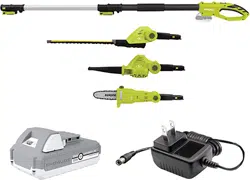Loading ...
Loading ...
Loading ...

mCAUTION! Do not use the pole hedge trimmer for
cutting stems greater than 0.6 inch (1.5 cm) thick.
Use the pole hedge trimmer only for cutting normal shrubbery
found around houses and buildings.
Do not force the pole hedge trimmer through dense growth.
A slight back and forth sawing action may ease the cutting of
larger, more dense growth. If the pole hedge trimmer begins to
slow down, reduce the rate of speed at which you are trying to
cut. If the pole hedge trimmer becomes jammed, immediately
turn the trimmer o. Remove the battery and clear the jammed
debris from the cutter blades.
Care + Maintenance
m
WARNING! Blades are sharp. When handling the blade
assembly, wear non-slip, heavy-duty protective gloves. Do not
place your hand or ngers between blades or in any position
where they could get pinched or cut. NEVER touch the blades
or service the unit with the battery inserted.
Lubricate the Blades
For easier operation and longer blade life, lubricate the pole
hedge trimmer blade before and after each use.
1. Stop the motor and remove the battery.
2. Lay the pole hedge trimmer on a at surface. Apply
lightweight machine oil along the edge of the top blade
(Fig. 46).
If you will be using the pole hedge trimmer for an extended
period, it is advisable to stop work intermittently in order to
re-oil the blade.
NOTE: Do not oil while the pole hedge trimmer is running.
Disposal
Recycling the tool
• Do not dispose of electrical appliances as unsorted
municipal waste. Use separate collection facilities.
• Contact your local government agency for information
regarding the collection systems available.
• If electrical appliances are disposed of in landlls
or dumps, hazardous substances can leak into the
groundwater and get into the food chain, damaging your
health and well-being.
• When replacing old appliances with new ones, the retailer
is legally obligated to take back your old appliance for
disposal at least free of charge.
Recycling + Disposal
The product comes in a package that protects it against
damage during shipping. Keep the package until you are
sure that all parts have been delivered and the product is
functioning properly. Recycle the package afterwards or keep
it for long-term storage.
WEEE symbol. Waste electrical products should not
be disposed of with household waste. Please recycle
where facilities exist. Check with your local authority
or local store for recycling regulations.
Battery Caution + Disposal
Always dispose of your battery pack according to federal,
state, and local regulations. Contact a recycling agency in your
area for recycling locations.
mCAUTION! Even discharged battery packs contain
some energy. Before disposing, use electrical tape to cover
the terminals to prevent the battery pack from shorting, which
could cause a re or explosion.
mWARNING! To reduce the risk of injury or explosion,
never burn or incinerate a battery pack even if it is damaged,
dead or completely discharged. When burned, toxic fumes and
materials are emitted into the surrounding atmosphere.
1. Batteries vary according to device. Consult your manual
for specic information.
2. Install only new batteries of the same type in your product
(where applicable).
3. Failure to insert batteries in the correct polarity, as
indicated in the battery compartment or manual, may
shorten the life of the batteries or cause batteries to leak.
4. Do not mix old and new batteries.
5. Do not mix Alkaline, Standard (Carbon-Zinc) or
Rechargeable (Nickel Cadmium, Nickel Metal Hydride, or
Lithium-Ion) batteries.
Fig. 46
24
Loading ...
Loading ...
Loading ...
